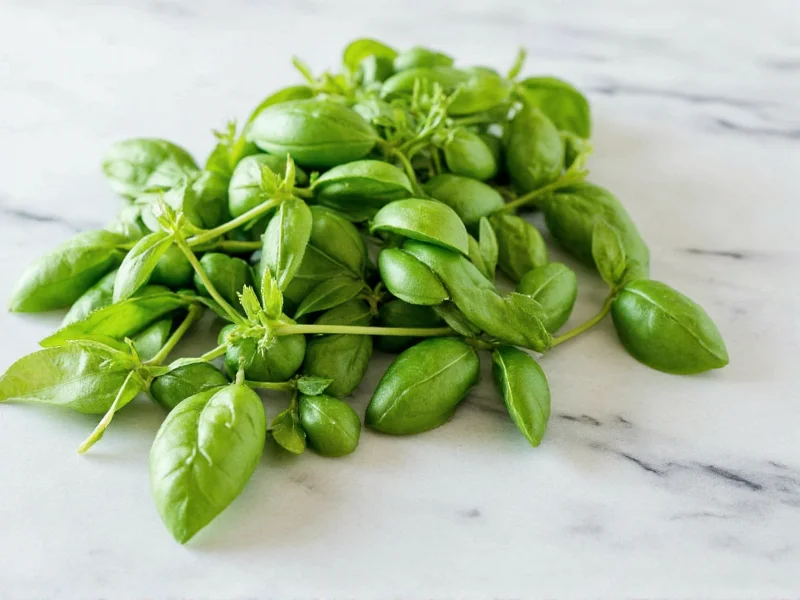Understanding basil fresh to dry conversion is essential for achieving balanced flavors in your cooking. Many home chefs make the mistake of using equal amounts when substituting, resulting in either under-seasoned dishes or overpowering herb flavors. The 3:1 ratio (fresh to dried) applies specifically to basil and most other leafy herbs, though some woody herbs like rosemary follow slightly different proportions.
Why Fresh and Dried Basil Aren't Interchangeable by Volume
Fresh basil contains approximately 90% water, which evaporates during the drying process. This concentration effect means dried basil delivers more intense flavor compounds per unit of volume. When you substitute dried basil for fresh without adjusting quantities, you're essentially using three times the intended herb concentration.
Complete Basil Measurement Conversion Chart
| Measurement | Fresh Basil | Dried Basil |
|---|---|---|
| Teaspoon | 3 tsp | 1 tsp |
| Tablespoon | 1 tbsp | 1/3 tbsp (1 tsp) |
| Cup | 1 cup | 1/3 cup |
| Ounce | 1 oz | 1/3 oz |
| Gram | 3 g | 1 g |
Practical Substitution Examples in Recipes
When adapting recipes that call for fresh basil but you only have dried (or vice versa), these real-world examples demonstrate proper conversion for common dishes:
- Pesto sauce: Traditional pesto requires 2 cups fresh basil. If using dried, substitute with 2/3 cup dried basil plus an additional 1-2 tablespoons of olive oil to compensate for the missing moisture content.
- Tomato basil soup: A recipe calling for 1/4 cup fresh basil needs only 1.5 tablespoons dried basil. Add dried basil early in cooking to allow flavors to infuse properly.
- Pasta dishes: For a caprese-inspired pasta with 3 tablespoons fresh basil, use exactly 1 tablespoon dried basil. Consider adding the dried basil during cooking rather than at the end for better flavor integration.
Maximizing Flavor When Substituting Basil Forms
Successful substitution involves more than just measurement conversion. Understanding how to use each form properly affects your dish's final taste:
Using dried basil effectively: Add dried basil early in the cooking process to allow time for rehydration and flavor release. The heat and liquid in your dish will help activate the concentrated essential oils. For best results, crush dried basil between your fingers before adding it to release more flavor compounds.
When fresh basil is preferable: Fresh basil shines in dishes where its delicate flavor and visual appeal matter—like caprese salad, fresh tomato dishes, or as a garnish. The bright, slightly sweet notes with hints of anise disappear when dried, replaced by a more earthy, concentrated flavor profile.
Storage considerations: Properly stored dried basil maintains potency for 1-2 years in an airtight container away from light and heat. Test older dried basil by rubbing a small amount between your fingers—if the aroma is weak, you'll need to increase the quantity slightly beyond the standard conversion ratio.
Common Substitution Mistakes to Avoid
Even experienced cooks sometimes misjudge basil conversions. Watch for these frequent errors:
- Equal substitution: Using 1:1 ratio instead of 3:1 creates overpowering herbal flavors that dominate other ingredients.
- Ignoring timing: Adding dried basil at the end of cooking prevents proper flavor development, while adding fresh basil too early diminishes its delicate notes.
- Not adjusting for age: Older dried herbs lose potency, requiring slight quantity increases beyond the standard conversion ratio.
- Misjudging recipe type: Using dried basil in cold dishes like salads or fresh sauces where its texture and flavor profile don't integrate well.
Special Considerations for Different Cooking Methods
The cooking technique affects how you should approach basil substitution:
Slow cooking: In crockpot or slow-cooked dishes, reduce dried basil quantities by 25% from the standard conversion, as prolonged cooking intensifies flavors. For a recipe calling for 1 cup fresh basil, use 1/4 cup dried rather than 1/3 cup.
Baking applications: When incorporating basil into breads or baked goods, use 75% of the standard dried basil conversion. The dry environment of baking concentrates flavors further.
Raw preparations: Avoid substituting dried basil in dishes that won't be cooked, like fresh salads or uncooked sauces. The texture and flavor profile simply don't translate well without heat and moisture to activate the dried herb.











 浙公网安备
33010002000092号
浙公网安备
33010002000092号 浙B2-20120091-4
浙B2-20120091-4